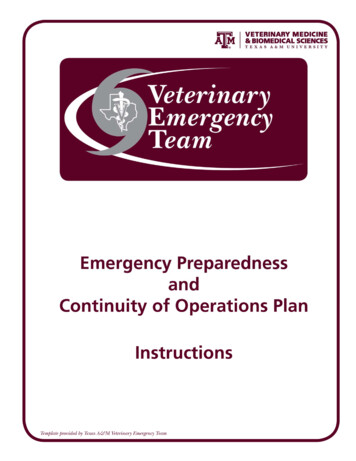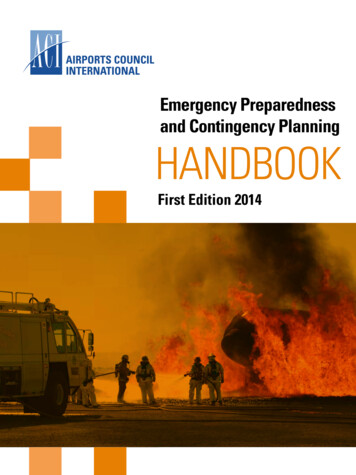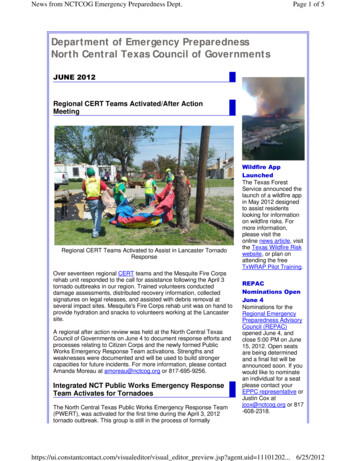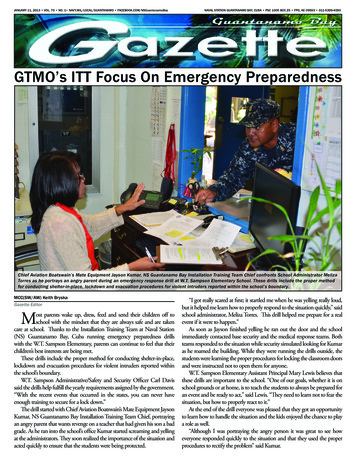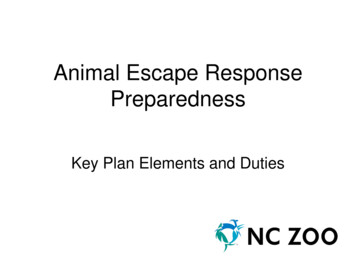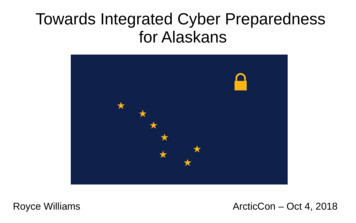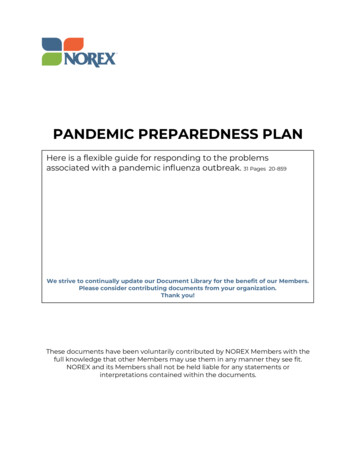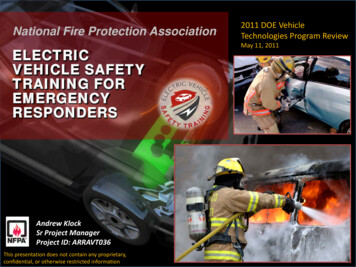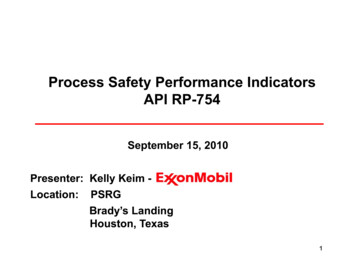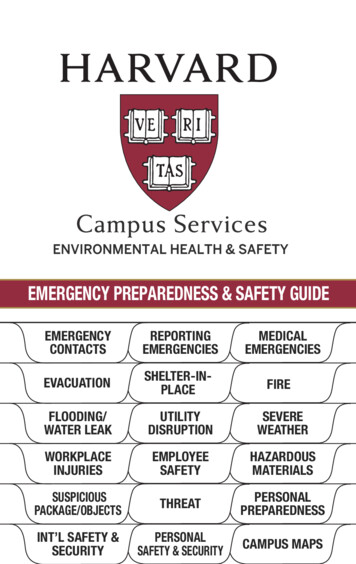
Transcription
EMERGENCY PREPAREDNESS & SAFETY TER /OBJECTSTHREATPERSONALPREPAREDNESSINT’L SAFETY &SECURITYPERSONALSAFETY & SECURITYCAMPUS MAPS
EMERGENCY CONTACT INFORMATIONCambridge/Boston Police,Fire and MedicalHarvard University Police(HUPD)University Operations Center (24x7)911617-495-1212617-495-5560Longwood Operations Center (24x7) 617-432-1901University Health ServicesUHS (Holyoke Center)Environmental Health & ENCYCONTACTS
EMERGENCY CONTACT INFO continuedHarvard News UpdatesHarvard Public Affairs& CommunicationsMotorist Assist ProgramOther:617-496-NEWS617-495-1585617-496-4357
REPORTING EMERGENCIESDial 911 for: Fire. Injury or Medical. Violence.Dial HUPD at 617-495-1212 for: Public Safety. Threat. Violence. Theft.Cambridge/Allston Campuses:Dial the University Operations Centerat 617-495-5560 (24x7) for: Fire/Smoke/Explosion (after notifying 911). Flooding. Hazardous Material. Utility Failure. Facilities Issues.continuedREPORTINGEMERGENCIES
REPORTING EMERGENCIES continuedLongwood Campus:Dial HMS/HSDM at 617-432-1901(24x7) for: Fire/Smoke/Explosion (after notifying 911). Flooding. Hazardous Material. Utility Failure. Facilities Issues.Tips for Reporting an Emergency: Report all injuries first. Try to call from a desk phone, not a cell phone. Describe the type of emergency (fire, medical, utilitydisruption, public safety, etc). Give the phone number you are calling from. Provide the address and room number of the emergency.continued
REPORTING EMERGENCIES continuedMessageMe:The University’s tool to communicate with the Harvard communitywhen there is an imminent and critical public safety issue.Sends emergency alerts to your personal electronic device.Sign up @ www.messageme.harvard.edu.Additional methods for Emergency Notifications: University-wide broadcast emails. www.harvard.edu/emergency. 617-496-6397 (NEWS). www.harvard.edu/emergency. Local school or department websites
MEDICAL EMERGENCIESDial 911 for all urgent medical emergencies. Additionally,urgent medical care is available to all staff and students (24 x 7)at UHS in Holyoke Center (617-495-5711). Familiarize yourselfwith the nearest first aid kit and Automated External Defibrillator(AED).Medical Treatment:If you suffer a serious injury, immediately seek medical attention. If necessary, Dial 911. Be prepared to answer all of the dispatcher’s questions. Provide the exact location of where you are calling from. If you receive medical treatment for a workplace relatedincident DO NOT give your personal Health InsuranceInformation. Instruct the Hospital that you suffered aworkplace injury and are a Harvard University employee.continuedMEDICALEMERGENCIES
MEDICAL EMERGENCIES continuedIf you witness a coworker become injured: DO NOT move the injured unless there is an immediate,life-threatening situation. If you believe they may havebeen electrocuted, do not touch them for any reason. Follow the instructions of the 911 emergency dispatcher.If necessary, they will send an ambulance and notifyHUPD to assist you. Send someone to retrieve the First Aid Kit and AED if available. Send someone to guide responders to the location of theperson needing assistance. Notify a supervisor. If necessary, contact the University Operations Centerat (617) 495-5560 (24x7) or the Longwood OperationsCenter at (617) 432-1901 (24x7).If safe, trained, and willing begin the steps of CPR/AED or First Aid.
EVACUATIONShould evacuation be necessary, go to the nearest exit orstairway and proceed to an area of refuge outside the building.Move at least 50 feet away from the building.Treat Every Building Alarm as an Emergency: Follow exit signs to exits and fire rated stairwells. If stairwell or exit is blocked or filled with smoke, find asecondary egress route. NEVER USE an elevator to evacuate. Once outside the building DO NOT re-enter. Go to yourdesignated meeting site.Planning in Advance: Know your primary and secondary evacuation routes inyour main building. Know where the closest fire alarm pull station is toyour office.continuedEVACUATION
EVACUATION continued Know who your local emergency evacuation monitor is. Review any of your department/school’s specific emergencyprocedures. If you have an impairment or disability that requires aspecific emergency evacuation plan, please contactyour local human resources representative or disabilitycoordinator.
SHELTER-IN PLACEThis procedure provides basic information and instruction forseeking shelter. In some emergencies, it is safer for you tostay indoors than it would be to evacuate. You may need toshelter-in-place for a variety of reasons, including, weather,chemical hazards, biological hazards, or public safetyemergencies. It is important to note that you may not knowwhich hazard you are sheltering from at the time thenotification is issued.Methods of Notification:If there is a hazardous condition which requires you toshelter-in-place, you may be notified through any of thefollowing means: MessageMe: Email, Text Phone message/voicemail. Face-to-face verbal communication.continuedSHELTER-INPLACE
SHELTER-IN PLACE continued Public address system of a building or emergency vehicle. AM/FM radio broadcast. Television broadcast. NOAA/NWS Weather Radio Broadcast.If you are OUTDOORS: Immediately move to the nearest building, alerting others in the area to the warning.
FIREIf you are INSIDE the building: STOP all activities and immediately initiate an evacuation. Close doors behind you as you exit, if it is safe to do so. Activate the nearest pull station if you do not alreadyhear the fire alarm. If you encounter visitors/guests, assist as necessary. Follow EXIT signs to the nearest fire stairwell. DO NOT use elevators. Leave the area by means of your primary evacuation route. If this exit is blocked or not safe for travel, use thesecondary route. Once outside the building, report to your designatedmeeting site. Wait for instructions. DO NOT re-enter building until Fire Department indicatesthat it is safe to do so.continuedFIRE
FIRE continuedRemember R.A.C.E.Relocate – remove yourself from immediate danger.Alarm – activate the fire alarm.Confine the fire as you leave by closing doors and windows.Evacuate from the building.Key Fire Safety Tips: Do not store cardboard, paper or other combustibles infire rated stairwells. Do not prop open fire rated doors, unless held open bymagnetic holds. Maintain 18” clearance beneath sprinkler heads. Do not block/obstruct emergency exits.continued
FIRE continuedRemember P.A.S.S.If you MUST use a fire extinguisher:Pull the safety pin on the grip handle.Aim the nozzle at the base of the fire.Squeeze the handles all the way together.Sweep the extinguisher from side to side.
FLOODING/ WATER LEAKImmediately notify the University Operations Center(617) 495-5560 (24x7), or the Longwood Operations Centerat (617) 432-1901 of any flood, back-up or leaking water.Reporting a problem: What is the source of the water (pipe, seepage, roofing, etc.)? How much water is present? How fast is the water entering the area? Is there any sewerage involved? Are there hazardous materials involved? Has anything been damaged? Specify if Harvard-ownedproperty, such as books, collections, equipment, orinfrastructure have been damaged. Is anything in danger of being damaged? Are any other utilities involved?DO NOT Enter Standing Water: Water can carry an electric current without any visiblesigns. This can be dangerous.continuedFLOODING/WATER LEAK
FLOODING/ WATER LEAK continued Assume the water is dangerous until a qualified assessmentis complete. Some flooding may contain hazardous materials or sewage. DO NOT use elevators during a flood.If SAFE To Do So: Turn off electrical devices. If there are hazardous materials involved (chemicals,asbestos, sewage, etc.), refer to the Hazardous MaterialsProcedure. If the water is entering from the roof and it is related toa storm, relocate to a safer area of the building or analternate location. Leaking from the roof following astorm may indicate structural instability or an otherwiseunsafe condition and needs to be inspected. Move property that may become wet or damaged to anelevated area. Use absorbent materials or barriers to contain the affected area. Isolate the affected area.DO NOT risk exposure to save property.
UTILITY DISRUPTIONThis procedure provides basic information relating to thedisruption of normal utility service, including heating, cooling,water, electricity, telecommunications, and the network.Contact:Building Manager for all local, non-emergency utility issues.University Operations Center: (617) 495-5560 (24 x 7) or theLongwood Operations Center at (617) 432-1901 (24 x 7). Heating. Cooling. Water (including pressure). Electricity. Fire Alarm Systems. Building Automation. Other unsafe conditions.HUIT Telephone Repair: (617) 495-4900 Telecommunications.continuedUTILITYDISRUPTION
UTILITY DISRUPTION continuedHUIT Help Desk: (617) 495-8411 Network. Computers. Software.If you feel the area is unsafe, evacuate the area and requestassistance according to the Reporting an Emergency Procedure. DO NOT burn candles. DO NOT use the elevators. If you are using only emergency lighting, leave the areaor find supplemental lighting. The emergency lightingwill typically last for approximately 90 minutes. Report the condition to the University Operations Center. Follow department-specific instructions to recoverbusiness operations. After reporting the disruption, inform others in the areathat “the University has been notified of the disruption andis working to correct the problem as soon as possible.”
SEVERE WEATHERTo determine if a work day is interrupted or cancelled due tosevere weather please contact 617-496-NEWS (6397) orfollow your local department’s protocols. Severe weatheremergencies may include: thunderstorms, snow storms, icestorms, tornadoes, hurricanes.If you encounter severe weather while at work: If outside get into a building, if inside stay inside! Stay away from windows. Major weather emergencies will be communicatedthrough Message Me.Winter Driving Tips: Call 617-496-6397 (NEWS) or checkwww.emergency.harvard.edu before leaving for work.Occasionally the University may cancel events or classes. Plan ahead, leave early to accommodate for slow conditions. Adjust your speed and safe following distance. Ensure you have plenty of windshield washer fluid. Keep fuel tank as full as possible.SEVEREWEATHER
WORKPLACE INJURIESAt Harvard University, all work related injuries and illnessesmust be reported. Below are guidelines to address specificreporting procedures.Injury and Illness Reporting: If seriously injured and in need of immediate medicalattention, Dial 911. ALL work related injuries or illnesses must be reported. If injured, you must complete an Accident Report Formwithin 24 hours of a work related injury or illness. Notify the University Operations Center (617) 495-5560(24x7) or the Longwood Operations Center at (617) 495-1901(24x7) in the event of a serious injury where the employee is transported by ambulance. Accident Report Forms can be obtained from:o Human Resources.o Your supervisor.o The EH&S website - www.ehs.harvard.edu.o www.harvie.harvard.edu. Return Accident Report Forms to your supervisor tocomplete and sign.continuedWORKPLACEINJURIES
WORKPLACE INJURIES continued Completed Accident Report Forms are then submitted toHuman Resources. Accidents that involve a fatality or three or more employeesinjured from the same incident must be immediatelyreported to the University Operations Center or EH&S.Determining if an Injury or Illness is“Work Related”: Definition: An injury or illness is considered to be workrelated if an event or exposure in the work environmenteither caused or contributed to the resulting condition orsignificantly aggravated a pre-existing injury or illness.
EMPLOYEE SAFETYThe Department of EH&S works with individual schools anddepartments to ensure safety, develop and deliver safety training,conduct hazard assessments and provide technical expertiseto ensure a safe working environment for employees.Tips for ensuring a safe workplace: Review specific safety procedures/protocols with yoursupervisor. Attend required job specific safety training. Report any unsafe conditions to your supervisor. If you need additional assistance contact EH&S at617-495-2060 or visit www.ehs.harvard.edu. Take responsibility for your personal safety.EMPLOYEESAFETY
HAZARDOUS MATERIALSIf you discover a chemical spill and the area isunsafe: DO NOT try to clean-up the spill. Evacuate immediately. Report spill to University Operations Center at(617) 495-5560 (24x7) or the Longwood OperationsCenter at (617) 432-1901 (24x7). Request exposed individuals to remain nearby untilemergency responders arrive. Isolate the area and await assistance. If exposed to a chemical, use an eyewash station oremergency shower. Immerse yourself or your eyes for15 minutes. Then seek medical attention if needed.If you are trained and can do so safely: Locate the Material Safety Data Sheet (MSDS) and provideit to responders. TURN OFF any sources of ignition.continuedHAZARDOUSMATERIALS
HAZARDOUS MATERIALS continued Provide assistance to the ill or injured (see Injury/IllnessProcedure). If individuals have been exposed, brush off any drychemicals and rinse the area thoroughly for 15 minutesor until medical assistance arrives. Prevent further release, but do not risk exposing yourself. Try to prevent the spill from entering drains or theenvironment by using any absorbent buffer which isavailable.Tips for reporting a spill: Has anyone been exposed? What has been released (gas, liquid, solid)? Do you know what the material name is? How much has been released? Is it actively being released, or has it slowed/stopped? Is the release contained, or is it entering the environment(sewer, soil, vents, etc.)? Are there sources of ignition nearby?
SUSPICIOUS PACKAGE / OBJECTThis procedure provides basic information relating tosuspicious packages or items. It can be utilized for any typeof package or object, including those with unknown contents.If you are holding a suspicious package / object: Gently set the item down on a solid surface or on thefloor. If there is powder or liquid, try to set the itemdown in a container like a trash can or bucket. Evacuate others from the immediate area. Leave the immediate area.If you locate a suspicious package / object: DO NOT touch or move the object. DO NOT activate the fire alarm system. Contact the Harvard University Police Department(HUPD) at (617) 495-1212. Evacuate only the immediate area. Isolate the area and do not allow anyone to enter untilHUPD has specifically said that the area is safe. Notify a supervisor or Local Emergency ManagementTeam representative. Request other witnesses to remain nearby to speak withHUPD responders. Remain available to assist responders.SUSPICIOUSPACKAGE/OBJECTS
THREATThis procedure provides information on what to do when youbecome aware of a threat. This includes bomb threats, cyberthreats, or threats of violence against the University, its property,or its interests.If you receive a threat: Refer all threats to the Harvard University PoliceDepartment at (617) 495-1212. If you receive the threat on the phone and if you can,ask the caller to hold and transfer the call to HUPD at(617) 495-1212. If you are unable to transfer the call, ask the caller tocontact HUPD directly. Obtain as much information as possible from the caller,and then contact HUPD with the information you collected. Answer any questions HUPD has for you. Remain available to further assist HUPD. Inform your supervisor or a member of your Local Emergency Management Team. DO NOT activate the fire alarm system unless instructedto do so by HUPD.continuedTHREAT
THREAT continuedTips for receiving and reporting a threat: Try to record the threat exactly as it is said. Note the time the threat was made. Be clear about the type of threat. If possible, record details about the threat: What will happen? Where will it happen? When will it happen? How can it be stopped? What is your general impression? Angry, confused, scared, etc. Did you notice any background noises. Ask for the individual’s name.
PERSONAL PREPAREDNESSReview the guide: Be familiar with how to obtain information from it duringan emergency. Know whom to contact for different types of emergencies,both to obtain assistance and report problems withinyour department. Be vigilant in your areas and report situations whichseem dangerous or suspicious. Review other safety resources such as the annualPlaying it Safe guide from HUPD www.hupd.harvard.edu,www.ehs.harvard.edu, resources available from HUHS,guidance from your local HR department or supervisor,www.ready.gov and www.arcbrcr.org for helpful tips andadvice. Take personal responsibility for your own preparednessby taking steps to educate and equip yourself for anemergency. Know the evacuation routes and meeting sites for youroffice and places you visit during the business day. Know your school or department policies regardingemergencies.continuedPERSONALPREPAREDNESS
PERSONAL PREPAREDNESS continued Know how you will get information from yourschool/department during an emergency.Sign up for MessageMe: www.messageme.harvard.edu. Review the EH&S webpage for resources available to you. Book Mark the Following Departments Websiteso EH&S www.ehs.harvard.edu.o HUPD www.hupd.harvard.edu.o Harvard Emergency www.emergency.harvard.edu.
INTERNATIONAL SAFETY & SECURITYIn an emergency abroad: Call the local equivalent of “911.” Call Harvard Travel Assist: 1 617 998 0000Before you go:Visit www.traveltools.harvard.edu and follow the pre-departuresteps including: Register your itinerary and contact information in theHarvard Travel Registry. Visit the Harvard Travel Assist website to learn aboutavailable services, eligibility guidelines, andcountry-specific information. Obtain a passport and required visas. Register with the embassy of your country of citizenship. Review your health insurance coverage abroad. Obtain a pre-travel health consultation.While you’re abroad: Keep emergency phone numbers easily accessible. Update the Harvard Travel Registry with any changes toyour travel plans or contact information. Contact Harvard Travel Assist for medical advice or referrals.continuedINT’L SAFETY &SECURITY
INTERNATIONAL SAFETY & SECURITY continued In an emergency, call the numbers listed above. Whenit is safe to do so, visit www.traveltools.harvard.edu andfollow the instructions to report medical or securityincidents to Global Support Services.Additional Resources: Global Support Services: www.traveltools.harvard.edu. US Dept. of State, Smart Traveler Enrollment Program:http://step.state.gov/step/. US Dept. of State, Travel Warnings:www.travel.state.gov/travel. CDC Travelers’ Health: wwwnc.cdc.gov/travel.
PERSONAL SAFETY & SECURITYReporting a Crime: If you see something say something! Call HUPD at(617) 495-1212. Harvard University has blue light police assisted phonesacross campus. These phones can be used for anyemergency situation. Reporting a crime anonymously: Call 617-496-2700 (24 x 7)or visit: www.hupd.harvard.edu/anonymous.php.If reporting a crime anonymously be as detailed as possiblein the message.Crime Awareness: Store emergency numbers in your phone. Lock your doors when leaving the office. Never leave your purse, pho
HUIT Help Desk: (617) 495-8411 Network. Computers. Software. If you feel the area is unsafe, evacuate the area and request assistance according to the Reporting an Emergency Procedure. DO NOT burn candles. DO NOT use the elevators. If you are using only emergenc
